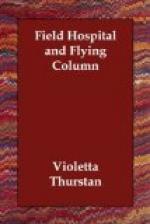There were masses of troops constantly going up to the positions from Skiernevice, and as there was a short cut through the park, which they generally used, we could see all that was going on from our rooms. On Sunday it was evident that another big battle was pending. Several batteries went up through our woods, each gun-carriage almost up to its axles in mud, dragged by eight strong horses. They were followed by a regiment of Cossacks, looking very fierce in their great black fur head-dresses, huge sheep-skin coats, and long spears. There was one small Cossack boy who was riding out with his father to the front and who could not have been more than eleven or twelve years old. There are quite a number of young boys at the front who make themselves very useful in taking messages, carrying ammunition, and so on. We had one little boy of thirteen in the hospital at Warsaw, who was badly wounded while carrying a message to the colonel, and he was afterwards awarded the St. George’s Cross.
There were enormous numbers of other troops too: Siberians, Tartars, Asiatic Russians from Turkestan, Caucasians in their beautiful black-and-silver uniforms, Little Russians from the south, and great fair-haired giants from the north.
The little Catholic Church in the village was full to overflowing at the early Mass that Sunday morning with men in full marching kit on their way out to the trenches. A very large number of them made their Confession and received the Blessed Sacrament before starting out, and for many, many of these it was their Viaticum, for the great battle began that afternoon, and few of the gallant fellows we saw going up to the trenches that morning ever returned again.
That afternoon the Prince had business at the Staff Headquarters out beyond Lowice, and I went out there in the automobile with him and Monsieur Goochkoff. We went through Lowice on the way there. The little town had been severely bombarded (it was taken two or three days later by the Germans), and we met many of the peasants hurrying away from it carrying their possessions with them. You may know the peasants of Lowice anywhere by their distinctive dress, which is the most brilliantly coloured peasant dress imaginable. The women wear gorgeous petticoats of orange, red and blue, or green in vertical stripes and a cape of the same material over their shoulders, a bright-coloured shawl, generally orange, on their heads, and brilliant bootlaces—magenta is the colour most affected. The men, too, wear trousers of the same kind of vertical stripes, generally of orange and black. These splashes of bright colour are delicious in this sad, grey country.




